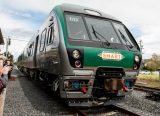Blog Post < Previous | Next >

SMART
SMART overstates ridership in applying for transportation grants
In 2015, the California Department of Transportation distributed $224 million of “cap and trade” funds in the form of the “Transit and Intercity Rail Capital Program.” As reported by the IJ in April, an $11 million grant from this rail program was awarded to the Sonoma-Marin Area Rail Transit train and path project. The money was to be used to add third middle-train cars to SMART’s two-car trains.
The rail program guidelines clearly stated that the primary evaluation criteria were to “reduce greenhouse gas emissions” and that “the highest rated applications that meet the program objectives will be selected for programming.”
end articleparagraph1.pbo start articleparagraph1.pbo
In August, a public records request to the state revealed the assumptions SMART used in its application.
SMART claimed that with three-car trains instead of two-car trains, daily ridership would increase from 20,016 to 30,312 riders a day.
What’s wrong with this?
These numbers do not represent train ridership. They represent train capacity.
As everyone who has followed SMART knows, its expected ridership is closer to 5,000 per day than 20,000, and that’s only after 20 years of operating.
In its federal Environmental Impact Statement prepared for the Federal Transit Administration last year, SMART projected ridership in 2035 would be 5,200 riders per day.
If one person traveled round-trip on SMART that would count as two riders.
SMART did not disclose anywhere in its application that the ridership is expected to start off at a much lower level.
Based on its financial plan, adopted last December, SMART’s start-up ridership in 2017 would be less than 2,000 per day and doesn’t even come close to 5,000 daily riders until 2028.
Of course, none of the expected ridership, based on SMART’s own projections, will exceed the capacity of the two-train set. And since train capacity won’t limit ridership for the foreseeable future, adding third cars will make zero difference, other than longer trains and higher consumption of the global warming diesel fuels SMART uses to propel their trains.
What could be more troublesome?
Earlier this year, SMART ran afoul the Metropolitan Transportation Commission in a similar grant application. The difference: MTC staff recognized what SMART was doing and denied the grant.
During the May 13 meeting of MTC’s Policy Advisory Council, former Marin County supervisor and SMART supporter Cynthia Murray had the audacity to ask MTC staff why SMART, whose application reduced emissions more than other applicants, was not awarded a grant that would theoretically reduce global warming gases.
An MTC staff member explained that SMART’s ridership forecast of over 30,000 was overstated. He said the MTC would have used a daily ridership number 30 to 50 times lower than SMART’s projections.
As Marin residents are aware, SMART has a long history of misleading voters about its ability to fund construction and operations from a quarter-cent sales tax. And it continues to do so every time it blames lower sales tax revenues for its inability to deliver the promised 70-mile rail line.
It never mentions that both construction costs and debt service are far lower than SMART had projected when placing Measure Q before the voters in 2008.
But SMART has now reached a new low.
The SMART board, which approved the application documents, has been criticized by two civil grand juries for not performing sufficient oversight. And this is a classic example of the board performing no due diligence over SMART staff.
Did the board even read the application before approving it?
SMART’s claim of 20,000 daily riders is ridiculous and embarrassing. Not even SMART board members expect anything close to this figure.
A formal complaint has been filed with the auditor of state transportation department. Hopefully, the state auditors will be the adults in the room.
SMART board members have completely shirked their responsibility and they should return the $11 million they were awarded under false pretenses.
Richard Hall of Terra Linda was a critic of the proposed Priority Development Area at SMART’s Civic Center station. Mike Arnold of Novato is co-chair of Marin Citizens for Effective Transportation.
